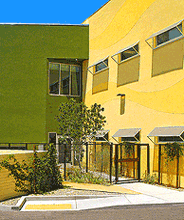Tucson, Arizona

LEED (tm) Leadership in Energy and Environmental Design
Project Credit Summary
Sustainable Sites Credits
Prereq 1: Construction Activity Pollution Prevention (required)
An Erosion and Sedimentation Control Plan was implemented for all construction activities on the site. This plan described measures for the prevention of soil loss during construction by stormwater runoff and/or wind erosion, thereby resulting in reduced sedimentation in nearby storm sewers and washes, and reducing the environmental effects of airborne particulate matter.
SSc1: Site Selection (1 point)
The clinic has been developed on a site that will support a reduced environmental impact as a result of its location. Site is not known to be prime farmland, public parkland, or a habitat for threatened or endangered species. Site is also above the floodplain and not in close proximity to any wetlands, water bodies, and streams.

SSc2: Development Density and Community Connectivity (1 point)
The clinic is located in an urban area with existing infrastructure, thereby protecting greenfields and preserving habitat and natural resources. Several basic services, such as banks, schools, and grocery stores are located within 1/2 mile walking distance of the site.
SSc4.1: Alternative Transportation - Public Transportation Access (1 point)
Access to several public transportation options, most notably the Roy Laos Transit Center, are provided within 1/4 mile walking distance to the site, thereby contributing to the reduction of pollution and land development impacts from automobile use.
SSc4.3: Alternative Transportation - Low Emission & Fuel Efficient Vehicles (1 point)
The clinic provides preferred parking for low-emitting and fuel-efficient vehicles for at least 5% of the total parking capacity of the site, thereby contributing to the reduction of pollution and land development impacts from automobile use. Considered "preferred", these spaces are located in close proximity to the clinic entrances.
SSc4.4: Alternative Transportation - Parking Capacity (1 point)
By limiting the availability of parking, the use of alternative forms of transportation are encouraged. To accomplish this, the parking area of the facility has been sized not to exceed the minimum local zoning requirements. The clinic utilizes existing excess parking areas and new expanded parking areas inside and outside of the LEED® project boundary to meet but not exceed the minimum parking requirements for both the clinic and the Neighborhood Center as a whole. As a result, the entire neighborhood center experienced a net reduction of 24 excess parking spaces from pre-development conditions.
SSc5.2: Site Development - Maximize Open Space (1 point)
The clinic provides a high ratio of open space to the development footprint. At 34,570 square feet, nearly 41% ofthe site has been preserved as vegetated open space, thereby promoting biodiversity, reducing the effects of urban heat islands, increasing stormwater infiltration, and fostering greater connections between people and the outdoors.
The entire roof the new clinic has been covered with a highly reflective coating, thereby reducing the effects of thermal gradient differences between developed and undeveloped areas of the site (heat island effect) as well as contributing to lower building cooling costs.
SSc8: Light Pollution Reduction (1 point)
Through the careful selection of appropriate interior and exterior fixtures, light pollution has been minimized. Interior lighting fixtures have been located as far away from windows as possible and specified to maintain the maximum light output. Lighting power densities for exterior area fixtures and landscape lighting also fall below the maximum ASHRAE recommendations. As a result, these measures will help to minimize light trespass from the building and site, reduce sky-glow to increase night sky access, improve nighttime visibility through glare reduction, and reduce impacts on nocturnal environments.
